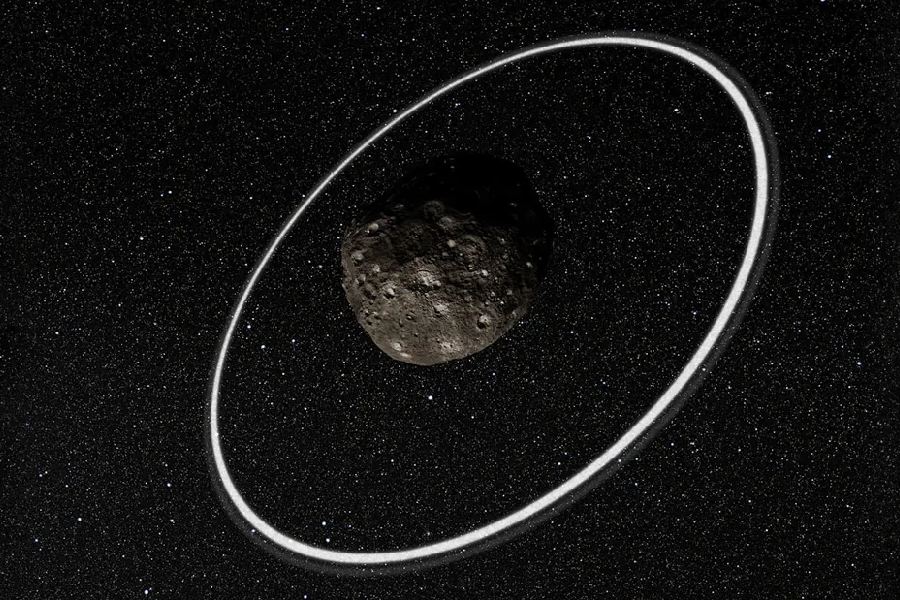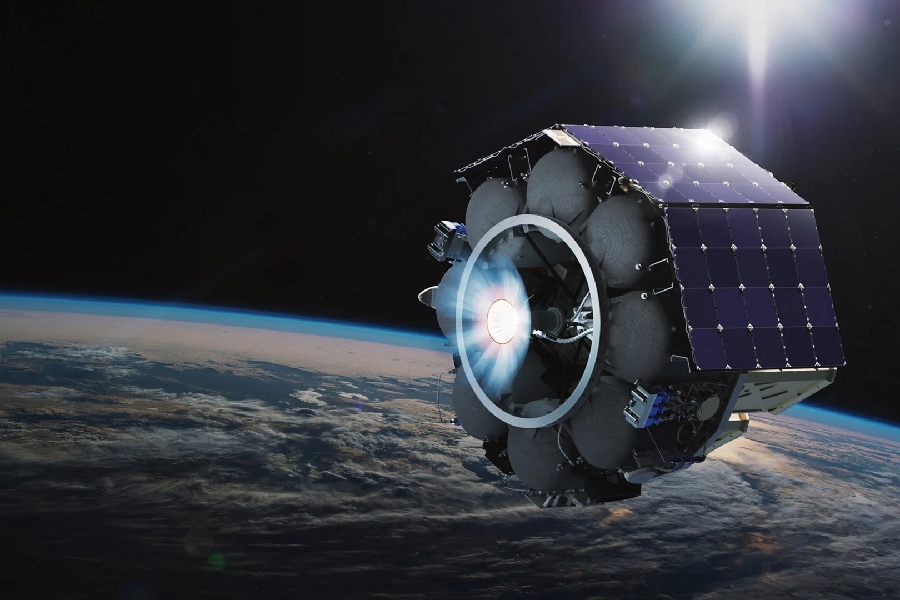Haumea is one of the most intriguing and mysterious objects in our solar system. This dwarf planet, nestled in the Kuiper Belt beyond Neptune, has an odd elongated shape and rapid rotation that leads to many questions. The biggest mystery surrounding Haumea is its composition, or more precisely, does Haumea have rings?
Many of the larger bodies in our solar system possess ring systems. The gas giants and some larger icy worlds beyond Neptune exhibit rings of dust and debris. Could Haumea also have faint rings that have eluded detection so far? Its rapid spin and distorted shape lend credit to the idea that ephemeral rings could exist.
In this article, we will explore what we currently know about Haumea and the evidence for and against Haumea rings. We’ll discuss past observational studies and what they did and did not find.
We’ll also touch on how rings could have formed around Haumea based on our current models of the distant Kuiper Belt. The mystery helps peel back layers of the intricate dynamics at play in our solar system’s outer reaches.

Does Haumea Have Rings?
Yes, the dwarf planet Haumea does have rings. In 2017, astronomers directly detected a faint ring about 70 km wide encircling Haumea after observing it pass in front of a distant star.
The ring lies on the same plane as Haumea’s equator and moon Hi’iaka, at a close distance to its surface. Analysis of the dynamics involved has provided tighter constraints about Haumea’s size, shape, and density.
Latest Developments on Possible Rings Around Haumea
Announcement of the discovery in 2017
In 2017, scientists announced the discovery of a ring around the dwarf planet Haumea. Haumea is located past Neptune in the outer solar system. The confirmation came from a stellar occultation event, which occurred when Haumea passed directly in front of a distant background star.
Observations and methods used in confirming the presence of rings
The transit of Haumea briefly dimmed the starlight. Analysis of the precise photometry showed extra dimming on the stellar brightness curve, which indicated a ring around Haumea’s main body. Follow-up observations have constrained properties like the ring’s width and orbital distance from Haumea’s center.
The ring is estimated at about 70 km wide. It orbits close to Haumea’s surface and equatorial plane. Studying the ring dynamics gives new estimates for Haumea’s shape, size, and density. The dwarf planet joins Chariklo and Chiron as small Kuiper Belt objects now confirmed to have rings.
Possible Factors for Rings Around Haumea
Haumea has an elongated, non-spherical shape. It spins faster than most solar system bodies its size. Haumea completes one rotation every four hours, with exceptional spin likely from an ancient impact. Haumea also exhibits one of the highest surface albedos detected. Its bright, icy surface reflects over 50% of incoming light.
The dwarf planet resembles bodies formed through mergers of smaller objects. Haumea’s oblong shape and rapid rotation provide enough centrifugal forces to have accumulated and sustained a ring over billions of years since its formation.
Impact hypothesis as a potential mechanism for ring formation
A possible explanation involves material being ejected during an ancient collision. This could originate from Haumea’s moons and strikingly high rotation. Ejected icy debris may have spread around Haumea, gradually accumulating into a rotating ring close to its equator where velocities balance out gravitational forces.
An impact origin of perhaps 4 billion years ago could have supplied ring and moon material originating from Haumea’s outer icy mantle. This fits models of the dwarf planet’s possible formation history and evolution through energetic early mergers or collisions.
Composition and characteristics of the rings
As we said, studies indicate Haumea’s ring exhibits remarkable flatness and a 70 km width. It likely consists of nearly pure water ice having high reflectivity similar to Haumea’s icy surface.
Dynamical constraints limit larger or closer rings that would be unstable. The ring’s precarious existence resonates with models of capturing after a possible ancient impact.
Haumea represents the first trans-Neptunian object confirmed to have rings. Yet conditions suggest other similar bodies may also harbor faint, icy rings awaiting discovery. Haumea’s ring offers a unique laboratory to analyze small icy worlds residing on our solar system’s outskirts and potential rings that may encircle them.

Gravitational Tug from a Satellite Companion Object
Influence of gravitational interactions with companion objects
Haumea hosts two known satellites named Hi’iaka and Namaka, which orbit the dwarf planet. The dwarf planet and moons likely formed from the same parent collision. Their births connect to a potential ancient impact, possibly creating Haumea’s rings, too.
The moons’ repetitive gravitational tugs on ring particles may contribute to confining and sculpting the rings over billions of years. The moons help dynamically shepherd the ring by preventing dispersion, keeping it narrow and well-defined.
Investigate how a satellite companion might contribute to ring formation
A past energetic impact could have birthed moons from the ejected material. Collisions between second-generation debris could supply additional particles for gradually accumulating into a ring orbiting with Hi’iaka and Namaka.
Ongoing gravitational stirring by the moons would aid in spreading ring particles into the current thin circular configuration stretched along Haumea’s equator. This balances gravitational, rotational, and radiation forces.
Specific findings or studies supporting this hypothesis
The ring’s orbit and orbital plane align extremely well with Hi’iaka’s path and Haumea’s equator, where rotational forces balance gravity. This precise alignment points to the dynamical coupling between Haumea, its satellite, and the ring, which is likely to originate from the same ancestral impact.
Impact of Discovering Rings Around Haumea
Significance of Haumea’s rings in the context of the Solar System
Finding a ring system around the distant Haumea expands our knowledge about small outer solar system worlds. It further blurs the line between what defines a planet versus a minor planet able to host rings. This fifty-fold smaller object resembles planetary ring behavior.
Pluto and Chariklo were the only other known ringed minor planets before. Haumea now triples examples of tiny icy worlds bearing rings and moons over 4 billion miles from the Sun. This reveals more diversity across space environments stretching far past Neptune.
Implications for ring systems on distant icy worlds
The discovery carries implications that additional larger Kuiper Belt objects may have hard-to-spot rings, too. Coupled with moons, faint shepherd rings could be more common artifacts from ancient collisions that formed many icy denizens inhabiting the outskirts of systems.
This shifts thinking about the requirements and processes for forming rings, which need not solely occur around massive planets. More mini-worlds past Pluto may yet yield newly uncovered rings.
Insights for planetary science and exoplanets
Finding a precisely tuned ring around a minor planet informs models about the origins and longer-term stability of rings, moons, and worlds at the solar system’s frontiers. This remote cosmic environment models conditions around other stars as well.
Studying tiny Haumea’s dynamics stretches considerations for where rings arise elsewhere, from icy dwarf planets to exoplanets residing at the outer edges of their parental star systems.
Conclusion
Observations in 2017 conclusively detected narrow rings encircling the dwarf planet Haumea. This makes Haumea the first known dwarf planet and Kuiper Belt Object with a ring system. The faint rings span about 70 kilometers in diameter and were only observable when they briefly blocked light from a distant star.
It is unusual for a body like Haumea to possess rings – its elongated shape, extremely rapid spin, and mass seem to provide just the right dynamics to allow these delicate rings to persist. If Haumea rotated any faster, it would likely break apart; any slower, and the rings would spread out further.
With the question, does haumea have rings answered, there are new questions to explore about how these rings formed and are sustained amidst the dwarf planet’s strange properties.
Through this article, we hope readers have gained awareness that even frigid, tiny worlds billions of miles away can contain wondrous surprises still being uncovered today.
